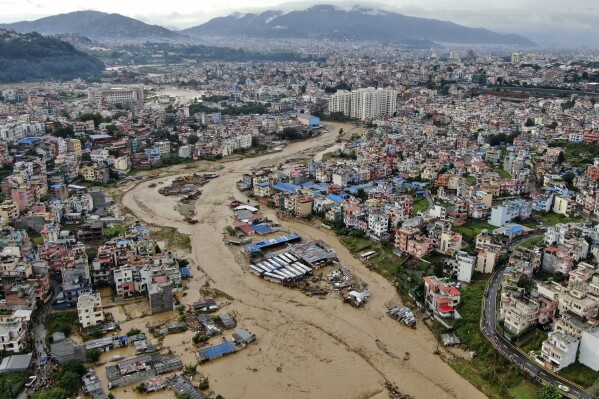Devastating Truth Behind Nepal’s Deadly Rainfall: Is Climate Change to Blame?

Nepal has been grappling with extreme weather events, including the recent devastating heavy rainfall that has led to catastrophic floods and landslides across the country. According to the latest reports, more than 50 people have lost their lives, with 32 fatalities reported in Kathmandu Valley alone. Over 1,200 homes have been submerged, dozens of individuals remain missing, and over 1,000 people have been rescued from flood-affected areas. A total of 44 districts have reported incidents of floods, landslides, and road blockages, further aggravating the situation.
The root cause of this disaster lies in the unusual weather patterns influenced by climate change. The 2024 monsoon season has brought 25% more rainfall than the average in Nepal, exacerbating the situation. The increased moisture content in the atmosphere and the development of low-pressure systems have triggered excessive rainfall, causing widespread destruction to infrastructure, roads, and homes. Rescue and relief efforts are ongoing, but the need for long-term solutions and improvements in disaster management is glaringly evident.
Monsoon Patterns and Climatic Shifts: A Global Overview
The monsoon season is vital for Nepal’s agricultural and water resources, but in recent years, it has become unpredictable and dangerous. The scientific reasoning behind this erratic behavior can be traced to global climate change, which has disrupted natural weather patterns worldwide.
At the heart of this phenomenon is the rise in global temperatures. The Earth's atmosphere is warming due to the continuous emission of greenhouse gases, primarily carbon dioxide and methane, from industrial activities and deforestation. As temperatures rise, so does the capacity of the atmosphere to hold moisture. Warm air holds more water vapor, which results in heavier rainfall during storm systems, especially during the monsoon season. In the case of Nepal, this has led to intense, concentrated rainfall that the local terrain and drainage systems are not equipped to handle.
In 2024, the monsoon system in South Asia experienced intensified rainfall due to these atmospheric changes. The warming of ocean surfaces, particularly in the Bay of Bengal and the Arabian Sea, has played a significant role in increasing the moisture content of the monsoon winds that sweep across the region. As these moisture-laden winds travel towards the Himalayas, they encounter Nepal's mountainous terrain, which forces them to release their moisture as heavy rainfall. This topographical factor exacerbates the risk of flash floods and landslides in a country with steep slopes and fragile soil conditions.
The Role of Low-Pressure Systems
Another major contributing factor to the recent heavy rainfall in Nepal is the development of low-pressure systems over the Indian subcontinent. These systems form due to differences in atmospheric pressure and temperature and are common during the monsoon season. However, in recent years, these low-pressure systems have become more frequent and intense, often resulting in prolonged periods of rainfall.
The Bay of Bengal, in particular, has been the origin of several low-pressure systems that have traveled northwards, bringing excessive moisture into Nepal. This influx of moisture, combined with the existing monsoon, has resulted in unusually heavy rainfall. The 2024 monsoon season has seen multiple such systems develop, further compounding the effects of the climate crisis.
Additionally, the Himalayan region is highly sensitive to atmospheric changes, and even small fluctuations in temperature can have outsized effects on precipitation. Nepal’s unique geographical position, situated between the Indian plains and the Tibetan Plateau, makes it particularly vulnerable to such disruptions.
Urbanization and Infrastructure Challenges
While climate change and atmospheric dynamics play a crucial role in heavy rainfall, human activities in Nepal have exacerbated the consequences. Rapid urbanization, especially in the Kathmandu Valley, has significantly altered the region's natural drainage systems. Concrete structures and paved roads prevent rainwater from seeping into the ground, increasing surface runoff and the likelihood of flooding.
The population density in Kathmandu has surged in recent decades, with new settlements being constructed in areas prone to flooding. Inadequate urban planning and a lack of proper drainage infrastructure have left the city ill-equipped to manage the heavy rainfall that has now become more frequent and intense due to climate change. As a result, even moderate rainfall events can lead to significant flooding in urban areas.
The situation in rural areas is equally dire. Deforestation and unregulated construction on steep slopes have increased the risk of landslides, as the soil loses its ability to absorb water and hold together. Landslides have already claimed numerous lives and caused widespread destruction in hilly regions of Nepal during the 2024 monsoon season.
Scientific Data on Monsoon Variability
Data from Nepal’s Department of Hydrology and Meteorology indicates that the intensity and duration of monsoon rainfall have been changing significantly in recent years. In 2024, Nepal experienced 25% more rainfall than the historical average during the monsoon season. This is consistent with global trends, where climate models predict that monsoon regions will experience more extreme rainfall events due to climate change.
The World Meteorological Organization (WMO) has also issued warnings about the impact of global warming on the Himalayan region. Rising temperatures are expected to intensify monsoons while also reducing the predictability of seasonal weather patterns. This combination of increased intensity and unpredictability makes it difficult for countries like Nepal to prepare for and mitigate the effects of extreme weather events.
The Path Forward: Long-Term Solutions
The recent floods and landslides in Nepal highlight the urgent need for comprehensive disaster management and climate adaptation strategies. While short-term relief efforts are critical, long-term planning is essential to reduce the impact of future extreme weather events.
Nepal must invest in improving its infrastructure, particularly in urban areas like Kathmandu. Drainage systems need to be modernized, and new construction should be regulated to prevent development in flood-prone areas. In rural regions, reforestation and sustainable land-use practices can help reduce the risk of landslides and improve the resilience of communities to heavy rainfall.
At a national level, Nepal must also prioritize climate change adaptation. This includes strengthening its disaster management systems, investing in early warning technologies, and raising public awareness about the risks of extreme weather. International cooperation and funding will also be crucial in helping Nepal build its capacity to respond to climate-related disasters.
Conclusion: A Climate Crisis Reality
The heavy rainfall and associated floods and landslides in Nepal during the 2024 monsoon season are a stark reminder of the growing threat posed by climate change. As global temperatures continue to rise, extreme weather events are expected to become more frequent and severe. For Nepal, a country highly vulnerable to these changes, the need for proactive measures to mitigate the effects of climate change has never been more urgent. Failure to act now will only result in more lives lost, homes destroyed, and communities devastated by natural disasters that are increasingly fueled by human-induced climate change.

![From Kathmandu to the World: How Excel Students Are Winning Big [Admission Open]](https://nepalaaja.com/img/70194/medium/excel-college-info-eng-nep-2342.jpg)
